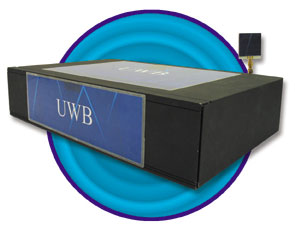|
by Sivanand Krishnan

 he United States Federal Communications Commission (FCC) has formulated the most widely accepted definition of ultra-wideband (UWB) at present - a UWB system with its frequency spectrum centred above 2.5GHz should have at least a 500MHz bandwidth, and systems with a frequency spectrum centred below 2.5GHz should have a bandwidth of at least 20%. he United States Federal Communications Commission (FCC) has formulated the most widely accepted definition of ultra-wideband (UWB) at present - a UWB system with its frequency spectrum centred above 2.5GHz should have at least a 500MHz bandwidth, and systems with a frequency spectrum centred below 2.5GHz should have a bandwidth of at least 20%.
In February 2002 the FCC legalised the use of UWB by releasing a set of spectral "masks" that stipulated the emission level and frequency of operation for imaging, radar, and communication purposes. With the ruling, the commercial viability of UWB was confirmed overnight and this sparked off a sudden surge of interest in the technology.
Long before the FCC ruling, several companies and research institutes had realised the vast potential of UWB and had begun studying it in detail. Singapore's Institute for Infocomm Research (I²R) was one of them. The research team at the Communications and Devices Division of the institute, confident of having understood the nuances of UWB, embarked on a project in July 2002 whose goal was to demonstrate a 500Mbps wireless UWB link within a year. The only comparable demonstration prior to their attempt was by Intel Corp in March 2002, using a system that communicated at 100Mbps.
Several challenges remained to be met. The first arose from generating the required short pulses. The generator had to output subnanosecond width pulses at a minimum pulse repetition frequency (PRF) of at least 500MHz. Existing pulse generators for such short pulses could only provide much lower repetition rates. To overcome this problem, team members built pulse-generation circuits, using their own proprietary design techniques. Their pulse generator could produce pulses at over 1GHz PRF with a pulse width of less than 0.3 nanosecond. This generation capability more than sufficed to meet their intended target speed.
Clearing the next hurdle required building an antenna that could transmit the generated pulses to the receiver with minimum distortion in the shape of the pulses. For this purpose, the team designed a special UWB planar antenna that had linear phase characteristics in the bandwidth of operation. They also made use of wideband pulse-shaping filters to ensure that the emitted signals conformed to the FCC spectral mask.
Other problems, such as interference from external signals, error-free detection of very fast rise-time signals, and hitches in the integration of analogue and digital parts, were overcome through ingenuity in system design and careful choice of components. The completed system was pushed to higher and higher speeds.
Finally, the team members achieved the target speed in April 2003. They were able to demonstrate a wireless UWB link working at a range in excess of 4m at speeds greater than 500Mbps. They had broken the UWB speed record of 220Mbps by more than two times while conforming to the FCC emission limits for this type of transmission.
The group at I²R is continuing to work on the various aspects of UWB. Its members engage in collaborative projects and actively participate in international standardisation activities in order to share their experience in building high-data-rate UWB systems with the scientific community. The researchers are also investigating the use of UWB in indoor-position location and radar applications, as well as in the design of compact and low-cost UWB antennas.
For more information contact Sivanand Krishnan at sivanand@i2r.a-star.edu.sg
|



 he United States Federal Communications Commission (FCC) has formulated the most widely accepted definition of ultra-wideband (UWB) at present - a UWB system with its frequency spectrum centred above 2.5GHz should have at least a 500MHz bandwidth, and systems with a frequency spectrum centred below 2.5GHz should have a bandwidth of at least 20%.
he United States Federal Communications Commission (FCC) has formulated the most widely accepted definition of ultra-wideband (UWB) at present - a UWB system with its frequency spectrum centred above 2.5GHz should have at least a 500MHz bandwidth, and systems with a frequency spectrum centred below 2.5GHz should have a bandwidth of at least 20%.